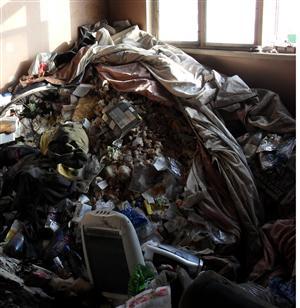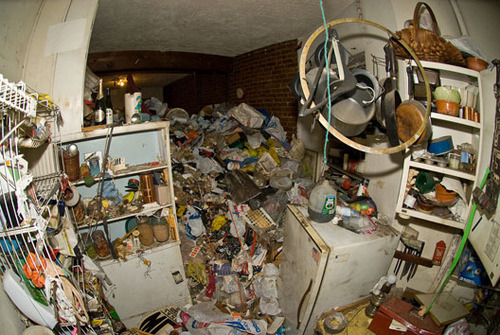We live in a throw away society with a market of disposable goods. Yet, as we grow older, we all tend to collect more and more material possessions. It's a fact of life. Most of us will strike a healthy balance and let go of possessions we no longer need. Depending on: our available space, life experience, mental health, and family tendencies, though, 2-5% of us will slowly allow material possessions to take over living space because of a condition known as hoarding disorder. Television has sensationalized it but non profits and mental health professionals are counterbalancing the stigma by conducting research into the disorder and developing supports for people faced with the potential legal, social, financial, or psychological consequences of having too much stuff.
 Hoarding is defined as difficulty discarding possessions regardless of the value commonly ascribed to them by others and/or holding onto possessions until they fill up living space and create fall or fire hazards. It's designated as a mental health disorder. Signs of risk can show up in young adulthood but become critical as we age and lose stamina to organize, encounter the need to downsize to smaller spaces, or, perhaps, suffer dementia, mental health issues or other circumstances preventing motivational drive or executive control. If family or concerned landlords step in to eliminate belongings it's often thorough and sudden which creates a new problem: personal trauma. If landlords deem the clutter dangerous it can result in eviction creating a more imminent peril: homelessness.
Hoarding is defined as difficulty discarding possessions regardless of the value commonly ascribed to them by others and/or holding onto possessions until they fill up living space and create fall or fire hazards. It's designated as a mental health disorder. Signs of risk can show up in young adulthood but become critical as we age and lose stamina to organize, encounter the need to downsize to smaller spaces, or, perhaps, suffer dementia, mental health issues or other circumstances preventing motivational drive or executive control. If family or concerned landlords step in to eliminate belongings it's often thorough and sudden which creates a new problem: personal trauma. If landlords deem the clutter dangerous it can result in eviction creating a more imminent peril: homelessness.
People who hoard often isolate. Consequently hoarding is usually discovered in an advanced state by a professional or family visitor. Rescue workers can encounter hoarding when responding to a call for urgent care or a fire fuled by possessions as in the 2012 Toronto blaze that ripped through a 30 floor 713 unit apartment. Hoarding can complicate the rescue of renters as this New Yorker article explains. That's why some first responders, such as fire fighters in Washington state, are teaming up with The Hoarding Project or other organizations to identify and refer potentially dangerous residences so that help arrives before hoarding causes accidents, death, or eviction.
 Professionals from mental health to real estate are on the front lines of lifting hoarding awareness. Ron Aiosa, a Coldwell Banker realtor, described his confrontation with myth and reality about hoarding to blogger Kathleen Lynn, at the Hoarding Disorder Resource and Training Group (HDRTG), "Getting a hoarder to actually clean up and prepare a house for a sale is almost impossible, to tell you the truth. If someone is a true hoarder, there is an illness attached to that, not just someone being lazy." Aiosa and other realtors are now turning to social service agencies and hoarding task forces for collaborative support and education on humane and effective ways to approach the situation. "You have to value how important their stuff is to them," social worker Marcie Cooper tells HDRTG citing a client who had trouble parting with, among other things, 1,000 ATM receipts. The reason? Disposing of them, the client confided, would cause her to feel like she had lost all of those days. Understanding the attachment to possessions and the drive to aquire them may promote healing of this complex disorder. However, more remains unknown than known about hoarding.
Professionals from mental health to real estate are on the front lines of lifting hoarding awareness. Ron Aiosa, a Coldwell Banker realtor, described his confrontation with myth and reality about hoarding to blogger Kathleen Lynn, at the Hoarding Disorder Resource and Training Group (HDRTG), "Getting a hoarder to actually clean up and prepare a house for a sale is almost impossible, to tell you the truth. If someone is a true hoarder, there is an illness attached to that, not just someone being lazy." Aiosa and other realtors are now turning to social service agencies and hoarding task forces for collaborative support and education on humane and effective ways to approach the situation. "You have to value how important their stuff is to them," social worker Marcie Cooper tells HDRTG citing a client who had trouble parting with, among other things, 1,000 ATM receipts. The reason? Disposing of them, the client confided, would cause her to feel like she had lost all of those days. Understanding the attachment to possessions and the drive to aquire them may promote healing of this complex disorder. However, more remains unknown than known about hoarding.
Conferences, task forces, and Hoarding Awareness Weeks are being organized all across the United States to raise awareness and offer support. Research is improving. Since 2013, mental health professionals have assigned it a distinct diagnostic code acknowledging that hoarding disorder can stand alone rather than always co-occuring, as previously believed, with other disorders. We know how it differs from simple collecting or clutter. Collectors organize and focus on acquisition of items in a particular theme. Their collections are ordered and don't overtake living space. Clutter features disorganized possessions but the owner has no major difficulty eliminating them or unusual drive to acquire them and they don't overtake living space. We know that hoarding disorder is difficult to treat and requires collaborative services. Data reveals that the common practice of forced downsizing without mental health support intensifies the behavior causing a greater drive to hoard in coming months and years. We have a general profile of someone typically seeking treatment for hoarding disorder: She's unmarried, living alone, and rarely has visitors. She's more likely to experience medical problems than her cohorts tending toward hypertension, arthritis, sleep apnea and high cholesterol.
Hoarding isn't organized collecting, eccentricity, or laziness it's a mental health disorder that requires compassion and professional support. "The best way to combat the disorder," Ricardo Aguilar, a member of The Hoarding Task Force of Greater Dallas tells the Dallas Morning News, "is to continue educating the community. Someone who hoards can go to a therapist once a week and have regular visits from social services, but is unlikely to make progress without daily support from friends and family. Really," he said, "the best treatment is empathy and a caring relationship.” Are you or is someone you know at risk of hoarding? Get involved. Your care and action can make a difference.

